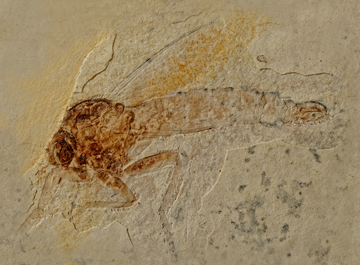Abstract
The Tingidae Laporte, 1832 is a family of small Hemiptera that are commonly referred to as lacebugs because the pronotum and fore wings of the adult have a delicate and intricate network of divided areas that resemble lace; they are considered as the sister group of Miridae (Schuh & Stys, 1991; Schuh et al., 2009). Tingidae are distributed worldwide with about 2,500 described species (Guilbert et al., 2014). They live on plants and are strictly phytophagous (sap-suckers).
References
Drake, C.J. & Davis, N.T. (1960) The morphology, phylogeny, and higher classification of the family Tingidae, including the description of a new genus and species of the subfamily Vianaidinae (Hemiptera: Heteroptera). Entomologica Americana (New Series), 39, 1–100.
Golub, V.B. (2001) Archepopovia yurii n. gen. n. sp. a new remarkable lace bug from Baltic amber, with some notes on phylogeny and classification of Tingidae (Heteroptera, Tingidae). Mitteilungen aus dem Geologisch-Paläontologischen Institut der Universität Hamburg, 85, 263–276.
Golub, V.B. & Popov, Y.A. (2000) A remarkable lace bug from Upper Cretaceous New Jersey amber (Heteroptera: Tingoidea, Vianaididae), with some phylogenetic commentary. In: Grimaldi, D. (Ed.), Studies on Fossils in Amber, with Particular Reference to the Cretaceous of New Jersey, Backhuys, Leiden, pp. 231–239.
Golub, V.B. & Popov, Y.A. (2008) A new species of Tingidae (Insecta: Hemiptera: Heteroptera) from the lower Cretaceous of Transbaikalia. Paleontological Journal, 42, 88–91.
Guilbert, E. (2001) Phylogeny and evolution of exaggerated traits among the Tingidae (Cimicomorpha, Heteroptera). Zoologica Scripta, 30, 313–324.
https://doi.org/10.1046/j.1463-6409.2001.00069.x
Guilbert, E. (2004) Do larvae evolve the same way as adults in Tingidae (Insecta: Heteroptera)? Cladistics, 20, 139–150.
https://doi.org/10.1111/j.1096-0031.2004.00015.x
Guilbert, E., Damgaard, J. & d’Haese, C. (2014) Phylogeny of the lacebugs (Insecta: Heteroptera: Tingidae) using morphological and molecular data. Systematic Entomology, 39, 431–441.
https://doi.org/10.1111/syen.12045
Guilbert, E. & Heiss, E. (2019a) New lacebugs (Hemiptera: Heteroptera: Tingidae) from Upper Cretaceous Burmese amber. Cretaceous Research, 94, 72–79.
https://doi.org/10.1016/j.cretres.2018.10.024
Guilbert, E. & Heiss, E. (2019b) New species of Tingiphatnoma from Cretaceous Burmese amber (Heteroptera, Tingidae). Palaeoentomology, 2 (4), 340–344.
https://doi.org/10.11646/palaeoentomology.2.4.7
Heiss, E., Golub, V.B. & Popov, Y.A., (2015) A new subfamily, genus and species of Tingidae (Hemiptera: Heteroptera) from Burmese amber. Zeitschrift der Arbeitsgemeinschaft Österreichischer Entomologen, 67, 1–9.
Heiss, E. & Guilbert, E. (2013) Two new genera and species of Tingidae from Cretaceous amber from Myanmar (Burma) (Hemiptera: Heteroptera). Zootaxa, 3736 (4), 379–386.
https://doi.org/10.11646/zootaxa.3736.4.5
Heiss, E. & Guilbert, E. (2018) A new species of Tingidae from Cretaceous amber from Myanmar (Burma). (Hemiptera: Heteroptera). Zootaxa, 4457 (2), 339–345.
https://doi.org/10.11646/zootaxa.4457.2.10
Kormilev, N.A. (1955) A new myrmecophile family of Hemiptera from the delta of Rio Parana, Argentina. Revista Ecuatoriana Entomologia y Parasitologia, 2, 465–477.
Laporte, F.L.N. de Caumont [Comte de Castelnau] (1833) Essai d’une classification systématique de l’ordre des Hémiptères (Hémiptères Hétéroptères, Latr.). Magasin de Zoologie, 2, 1–88.
Lis, B. (1999) Phylogeny and classification of Cantacaderini [Cantacaderidae stat. nov.] (Hemiptera: Tingoidea). Annales Zoologici, Warszawa, 49, 157–196.
Schuh, R.T. & Štys, P. (1991) Phylogenetic analysis of cimicomorphan family relationships (Heteroptera). Journal of the New York Entomological Society, 99, 298–350.
Schuh, R.T., Cassis, G. & Guilbert, E. (2006) Description of the first recent macropterous species of Vianaidinae (Heteroptera: Tingidae) with comments on the phylogenetic relationships of the family within the Cimicomorpha. Journal of the New York Entomological Society, 114, 38–53.
https://doi.org/10.1664/0028-7199(2006)114[38:DOTFRM]2.0.CO;2
Schuh, R.T., Weirauch, R. & Wheeler, W.C. (2009) Phylogenetic relationships within the Cimicomorpha (Hemiptera: Heteroptera): a total-evidence analysis. Systematic Entomology, 34, 15–48.
https://doi.org/10.1111/j.1365-3113.2008.00436.x
Stål, C. (1873) Enumeratio Hemipterorum, vol. 3. Kongliga Svenska Vetenskaps-Akademiens Handlingar, 11, 1–163.

